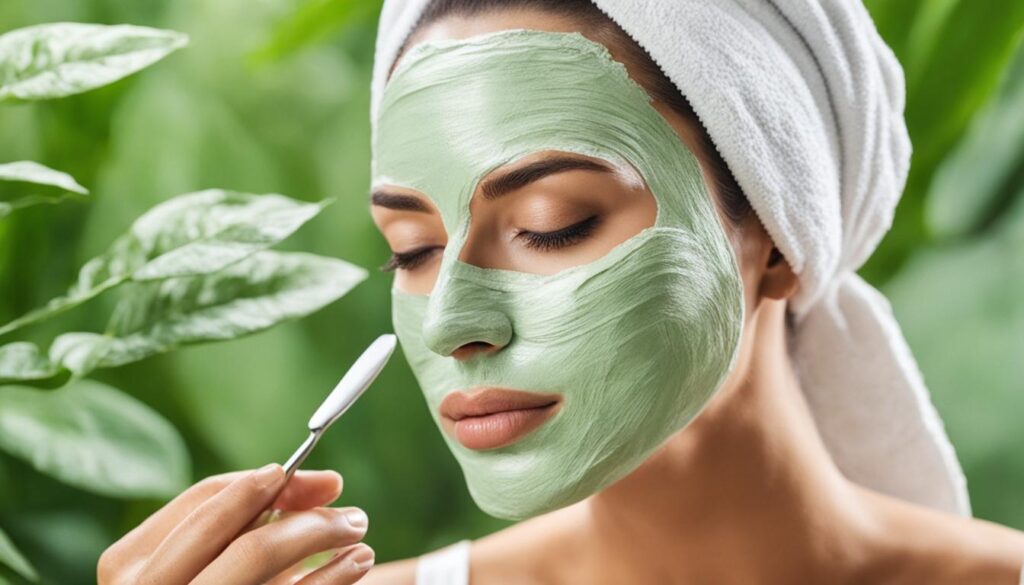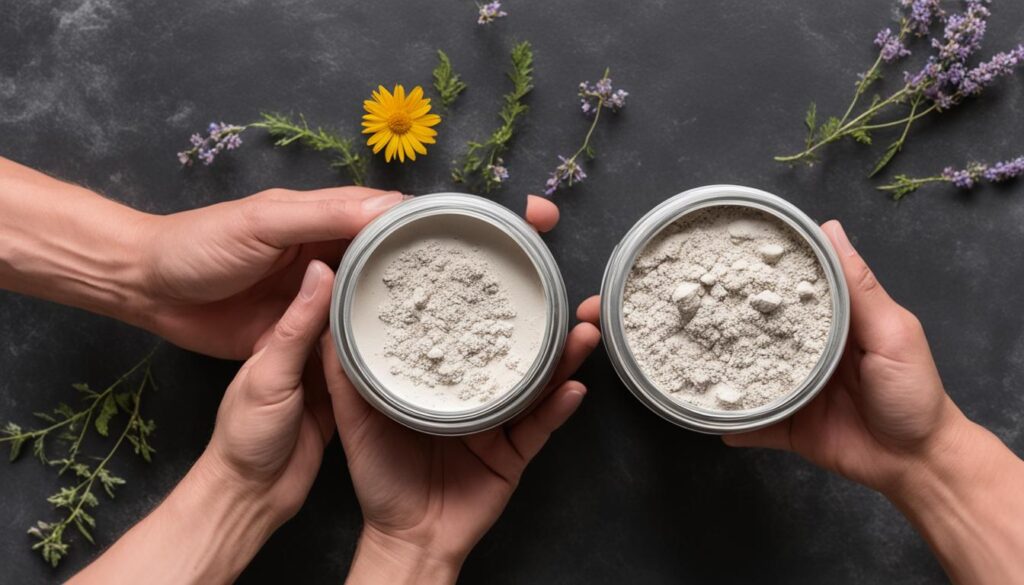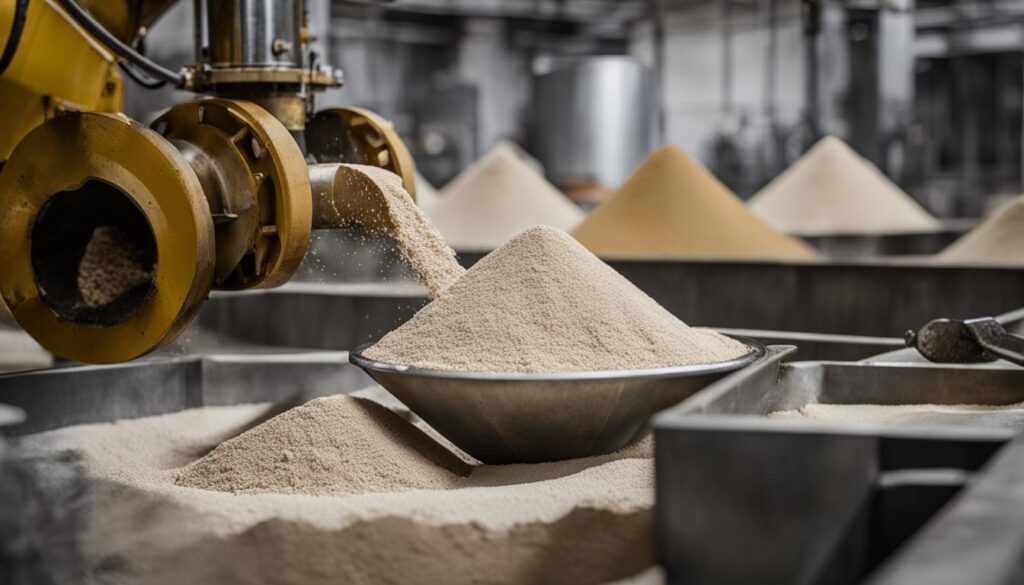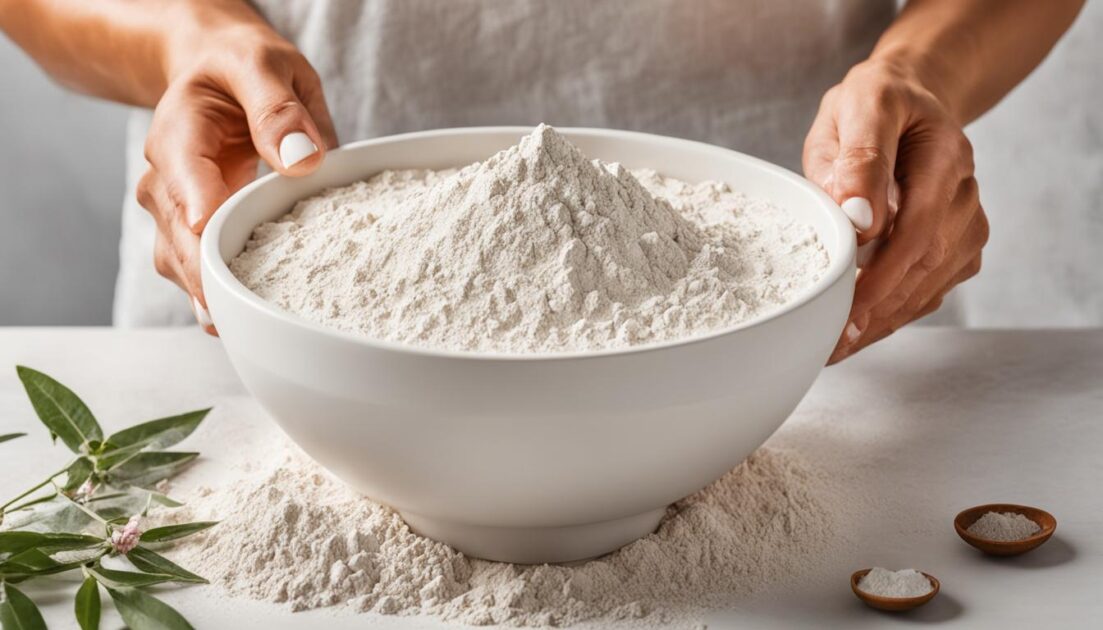Kaolin clay, also known as China clay, is a versatile natural ingredient with numerous benefits for skin health. From controlling oiliness and detoxifying the skin to soothing irritation and improving skin tone, kaolin clay offers a wide range of advantages. In this article, I will explore the various benefits of kaolin clay, its uses in skincare and haircare, and its properties that make it ideal for sensitive skin. Discover how incorporating kaolin clay into your beauty routine can enhance your skin health naturally.
Key Takeaways:
- Kaolin clay offers a multitude of benefits for skin health, including gentle exfoliation, oil control, acne treatment, soothing and calming properties, detoxification, and improved skin tone.
- It is suitable for all skin types, including sensitive skin, and can be used in various skincare formulations due to its versatility.
- Incorporating kaolin clay into DIY skincare recipes such as face masks can provide additional benefits and customization options.
- Kaolin clay has a rich history and cultural significance, particularly in China, where it has been used in pottery, ceramics, and traditional medicine.
- Using kaolin clay in haircare can promote scalp health, cleanse the hair, and contribute to healthy hair growth.
What Is Kaolin Clay and Its Origins?
Kaolin clay, also referred to as China clay, is a naturally occurring mineral substance with a soft texture. It gets its name from the Kaoling hill in China, where it was first discovered and used. Kaolin clay is primarily composed of a mineral called kaolinite. While it is typically white, it can also come in pinkish or greenish shades depending on the other minerals present in the clay. The whiter the clay, the purer and better its quality. Kaolin clay has a neutral pH and is rich in silica dioxide. Its origins in China and its extensive use in various industries, including porcelain making and traditional medicine, have contributed to its popularity.
The Benefits of Kaolin Clay for Skin

Kaolin clay offers a multitude of benefits for skin health. Its gentle exfoliating properties help remove dead skin cells and impurities, promoting a smoother and brighter complexion. The clay’s absorbent nature makes it effective in controlling oiliness and reducing the risk of clogged pores and acne breakouts.
Derived from naturally occurring minerals, kaolin clay has soothing and calming properties, making it suitable for sensitive and irritated skin. It can help reduce redness and inflammation, providing relief and comfort.
In addition to its cleansing and soothing abilities, kaolin clay is known for its detoxifying properties. It acts as a magnet, drawing out impurities and pollutants from the skin, leaving it purified and refreshed. This detoxification process can help improve overall skin tone and texture.
Another notable benefit of kaolin clay is its ability to hydrate the skin without causing excessive dryness. It helps to retain moisture, preventing the skin from becoming dehydrated and maintaining a healthy and plump appearance.
One of the advantages of kaolin clay is its non-comedogenic nature, meaning it does not clog pores. This makes it suitable for all skin types, including oily and acne-prone skin. The versatile formulation of kaolin clay allows it to be incorporated into various skincare products, making it a valuable ingredient in the clean beauty movement.
Incorporating kaolin clay into your skincare routine can contribute to achieving radiant and glowing skin. By harnessing its gentle exfoliation, oil control, acne treatment, soothing and calming, detoxification, improved skin tone, hydration, and non-comedogenic properties, you can unlock the full potential of kaolin clay for effective and natural skincare.
Kaolin Clay Benefits for Skin
| Gentle Exfoliation | Removes dead skin cells and impurities for a smoother complexion |
|---|---|
| Oil Control | Helps regulate sebum production to reduce oiliness |
| Acne Treatment | Reduces the risk of clogged pores and breakouts |
| Soothing and Calming | Relieves irritation and inflammation |
| Detoxification | Draws out impurities and pollutants from the skin |
| Improved Skin Tone | Enhances overall complexion and texture |
| Hydration | Retains moisture and prevents dehydration |
| Non-Comedogenic | Does not clog pores |
| Versatile Formulation | Can be incorporated into various skincare products |
| Clean Beauty | Aligns with the trend of natural and eco-friendly skincare |
| Radiant and Glowing Skin | Enhances the overall appearance of the skin |
Kaolin Clay Recipes for DIY Skincare
Making DIY skincare products with kaolin clay is easy and fun. There are various recipes that you can try at home to harness the benefits of this versatile clay.
- Kaolin Clay and Green Tea Face Mask: Combine the detoxifying properties of kaolin clay with the antioxidant benefits of green tea. This face mask helps cleanse and rejuvenate your skin.
- Kaolin Clay and Avocado Face Mask: Incorporate the nourishing properties of avocado with kaolin clay to provide hydration and boost skin elasticity.
- Kaolin Clay and Apple Cider Vinegar Face Mask: Enjoy a deep cleaning experience by combining the purifying properties of kaolin clay with the gentle exfoliation of apple cider vinegar.
- Kaolin Clay and Honey Face Mask: Soothe and moisturize your skin with this face mask that combines the hydration benefits of honey with kaolin clay’s gentle exfoliation.
- Kaolin Clay and Witch Hazel Face Mask: Purify your skin with a face mask that combines the purifying properties of witch hazel with the gentle exfoliation of kaolin clay.
These DIY recipes allow you to customize your skincare routine and enjoy the benefits of kaolin clay from the comfort of your home.
Kaolin Clay vs. Bentonite Clay: A Comparison

Kaolin clay and bentonite clay are two popular clays used in skincare, and they each offer unique benefits. Let’s take a closer look at the differences between these two clays.
Kaolin Clay
Kaolin clay is gentle and suited for all skin types. It provides gentle exfoliation, oil control, and improved skin tone without causing dryness. This clay is known for its ability to draw out impurities and toxins from the skin, leaving it purified and refreshed. Kaolin clay is also rich in minerals that nourish the skin, promoting a healthy and radiant complexion.
Bentonite Clay
On the other hand, bentonite clay is more absorbent and suitable for oily or acne-prone skin. It has stronger detoxifying properties and can help reduce inflammation. Bentonite clay is highly effective in drawing out excess oil, dirt, and toxins from the skin, making it an excellent choice for deep cleansing. It also has antimicrobial properties that can help combat acne-causing bacteria.
The choice between kaolin clay and bentonite clay depends on your skin type and specific skincare needs. If you have dry or sensitive skin, kaolin clay may be the better option due to its gentle nature. For oily or acne-prone skin, bentonite clay may provide more effective oil control and detoxification benefits.
It’s important to note that both clays should be used in moderation and followed by proper cleansing and moisturizing to prevent any potential dryness. As with any new skincare product, it’s recommended to perform a patch test before applying either clay to the entire face to ensure compatibility with your skin.
| Kaolin Clay | Bentonite Clay |
|---|---|
| Gentle and suited for all skin types | More absorbent and suitable for oily or acne-prone skin |
| Provides gentle exfoliation, oil control, and improved skin tone | Stronger detoxifying properties and helps reduce inflammation |
| Draws out impurities and toxins from the skin | Highly effective in drawing out excess oil, dirt, and toxins |
| Rich in minerals that nourish the skin | Antimicrobial properties that combat acne-causing bacteria |
By understanding the differences between kaolin clay and bentonite clay, you can make an informed decision and choose the clay that best suits your skincare needs. Whether you opt for the gentle exfoliation of kaolin clay or the powerful detoxification of bentonite clay, incorporating these natural clays into your skincare routine can help enhance your overall skin health.
The Versatility of Kaolin Clay in Various Industries

Kaolin clay, known for its numerous benefits in skincare, also finds applications in various industries. Its unique properties make it a valuable ingredient in pottery and ceramics, pharmaceuticals, and agriculture.
Kaolin Clay in Pottery and Ceramics
Kaolin clay’s fine texture and ability to enhance the quality of finished products make it highly sought after in the pottery and ceramics industry. Its presence in clay formulations helps create smoother surfaces and increased plasticity, resulting in improved workability and better overall product quality.
Pharmaceutical Applications of Kaolin Clay
Thanks to its soothing and anti-inflammatory properties, kaolin clay is widely used in the pharmaceutical industry. It can be found in medications and creams for various skin conditions, providing relief to those suffering from irritations, rashes, and inflammatory conditions.
Agricultural Uses of Kaolin Clay
Kaolin clay also plays an essential role in agriculture. Its ability to improve soil fertility and act as a natural pesticide makes it a valuable resource for farmers. When applied to crops, kaolin clay can deter pests, reduce sunburn, and regulate the temperature of plants, ultimately contributing to healthier and more productive harvests.
The Versatility of Kaolin Clay
| Industry | Applications |
|---|---|
| Pottery and Ceramics | Enhanced quality, smoother surfaces, improved workability |
| Pharmaceuticals | Soothing and anti-inflammatory properties for skin conditions |
| Agriculture | Improved soil fertility, natural pesticide, temperature regulation |
In conclusion, kaolin clay’s versatility extends beyond skincare. Its applications in pottery and ceramics, pharmaceuticals, and agriculture showcase its value in various industries. Whether enhancing the quality of ceramic products, providing relief in pharmaceuticals, or contributing to healthier crops, kaolin clay continues to be a valuable and versatile natural resource.
The Cultural Significance of Kaolin Clay

Kaolin clay, with its origins in China and association with the Kaoling hill, holds immense cultural significance, particularly in China where it has been revered for centuries. This versatile clay has been an integral part of Chinese culture and traditions, making its mark in various aspects of daily life.
One of the most notable uses of kaolin clay in Chinese culture is in pottery and ceramics. The Chinese have long recognized the exceptional properties of kaolin clay, utilizing it to create exquisite porcelain and ceramic pieces. The fine texture and purity of kaolin clay contribute to its ability to produce high-quality ceramic art, making it an essential ingredient in China’s renowned ceramic industry.
Furthermore, kaolin clay has historical uses in traditional medicine in China. Its medicinal properties have been harnessed for centuries, particularly in treating digestive ailments such as diarrhea. Chinese herbal medicine has incorporated kaolin clay as an effective remedy due to its ability to soothe the digestive system and alleviate symptoms caused by gastrointestinal disturbances.
Within the realm of Chinese culture, kaolin clay exemplifies the intersection of artistry, tradition, and natural remedies. Its historical uses in pottery, ceramics, and traditional medicine highlight its long-standing value and enduring significance in Chinese society.
Historical Uses of Kaolin Clay in China:
| Aspect of Chinese Culture | Historical Use of Kaolin Clay |
|---|---|
| Pottery and Ceramics | Used in the production of high-quality porcelain and ceramics |
| Traditional Medicine | Utilized to treat digestive ailments, including diarrhea |
The Sustainability and Eco-Friendliness of Kaolin Clay

Kaolin clay is a natural and eco-friendly ingredient that can be sourced sustainably. Its mining process involves extracting the clay from the earth, which minimizes the need for extensive processing and reduces its environmental impact. In contrast to synthetic alternatives, kaolin clay is a renewable resource that can be responsibly harvested, ensuring its long-term availability for various industries.
One of the key aspects of kaolin clay’s sustainability is its minimal carbon footprint. Its production involves minimal energy consumption, and it does not require harmful chemicals or additives for its formation. This eco-friendly nature aligns with the principles of clean beauty and sustainable sourcing.
Furthermore, choosing products that incorporate responsibly sourced kaolin clay supports environmentally friendly practices. By opting for brands that prioritize sustainable sourcing and production methods, consumers can contribute to the reduction of environmental degradation and promote a more sustainable future.
Eco-Friendly Features of Kaolin Clay:
- Renewable and responsibly sourced.
- Minimal carbon footprint.
- Environmentally friendly production process.
- No need for harmful chemicals or additives.
- Aligns with the principles of clean beauty and sustainability.
| Eco-Friendly Benefits | Implications for Sustainability |
|---|---|
| Natural and renewable resource | Conserves natural resources for future generations |
| Minimal carbon footprint | Reduces greenhouse gas emissions and mitigates climate change |
| Responsible sourcing | Promotes ethical practices and supports local communities |
| Reduced chemical usage | Protects ecosystems and reduces environmental pollution |
“The sustainable sourcing and production of kaolin clay contribute to its eco-friendliness and align with the growing demand for clean and sustainable beauty products.”
In summary, kaolin clay is not only beneficial for the skin but also for the environment. Its sustainable sourcing, minimal processing requirements, and environmentally friendly properties make it an eco-conscious choice for consumers looking to incorporate clean beauty products into their skincare routines. By supporting responsible sourcing practices, individuals can contribute to a more sustainable future while enjoying the various benefits of kaolin clay.
Maintaining Skin Health with Kaolin Clay and Other Skincare Practices
While kaolin clay offers numerous benefits for skin health, maintaining overall skin health requires a holistic approach. Incorporating kaolin clay into your skincare routine is a great step towards achieving healthy and radiant skin, but there are other essential practices to consider as well.
First and foremost, hydration plays a crucial role in maintaining skin health. Keeping your skin well-hydrated is not only important for its overall appearance but also for its function. Make sure to drink plenty of water throughout the day and use moisturizers that suit your skin type. Hydration helps to maintain skin elasticity, improve texture, and prevent dryness.
In addition to hydration, following a consistent skincare routine is essential. Cleansing, toning, and moisturizing should be the core steps of your daily skincare regimen. Cleansing removes dirt, oil, and impurities from the skin, while toning helps to balance the pH levels and tighten the pores. Moisturizing provides hydration and nourishment, promoting a healthy complexion.
Tip: It’s important to choose skincare products that are suitable for your skin type and address your specific concerns. Consult with a dermatologist or skincare professional to find the best products for your skin.
In addition to kaolin clay and a consistent skincare routine, maintaining a balanced diet is crucial for healthy skin. Consuming a diet rich in fruits, vegetables, and healthy fats provides the necessary vitamins and minerals that support skin health. Antioxidant-rich foods, such as berries and leafy greens, help to fight against free radicals and promote a youthful complexion.
Lastly, protecting your skin from the sun’s harmful UV rays is paramount in maintaining its health and preventing premature aging. Always apply sunscreen with a broad spectrum of SPF 30 or higher before going out in the sun. This helps to shield your skin from sun damage, including sunburn, wrinkles, and even skin cancer.
Incorporating these skincare practices alongside the benefits of kaolin clay can help you achieve optimal skin health. Remember to prioritize hydration, follow a consistent skincare routine, maintain a balanced diet, and protect your skin from the sun. By taking a holistic approach to skincare, you can enjoy healthy, glowing skin for years to come.
How to Use Kaolin Clay for Optimal Results
To experience the full benefits of kaolin clay, it is important to use it correctly and in moderation. Incorporating kaolin clay into your skincare routine can enhance your skin health naturally. Here are some tips to help you achieve optimal results:
- Frequency of Use: Kaolin clay can be used on the skin 1 to 2 times a week for 10 minutes. This frequency allows the clay to effectively remove impurities and detoxify the skin without over-drying it.
- Tailor to Your Skin Type: If you have dry skin, it is essential to moderate the use of kaolin clay to prevent excessive dryness. Adjust the frequency of use to maintain a balance between the clay’s oil control properties and your skin’s hydration needs.
- Follow Instructions: Always follow the instructions provided with the product. Each kaolin clay formulation may have specific guidelines for application, removal, and post-care. Adhering to these instructions ensures optimal results and minimizes the risk of adverse reactions.
- Cleanse and Moisturize: Before applying kaolin clay, cleanse your skin thoroughly to remove any makeup, dirt, or excess oil. After rinsing off the clay, follow up with a moisturizer to prevent dryness and maintain skin hydration.
- Customize for Oily Skin: If you have oily skin, you may benefit from using kaolin clay masks twice a week. This frequency helps control oil production and maintain a matte complexion.
Understanding how to use kaolin clay properly and incorporating it into a well-rounded skincare routine can help you achieve optimal results. Harness the power of kaolin clay and unlock the potential for healthier, more radiant skin.
Exploring Kaolin Clay for Haircare

Discover the amazing benefits of kaolin clay for your hair and scalp health. Kaolin clay, renowned for its versatility and effectiveness in skincare, also offers a range of advantages when it comes to haircare. Incorporating kaolin clay into your haircare routine can help keep your scalp clean, strengthen your hair roots, and promote healthy hair growth. Let’s explore how kaolin clay can contribute to luscious, healthy hair.
Kaolin clay acts as a natural cleanser for the scalp, effectively removing dirt, oil, and impurities. It gently cleanses without stripping away the natural oils, making it an ideal alternative to commercial shampoos that can be harsh and drying. By keeping the scalp clean, kaolin clay helps maintain a healthy environment for hair growth.
The use of kaolin clay on the hair also stimulates blood circulation to the scalp, which can promote healthy hair growth. Improved blood flow delivers essential nutrients to the hair follicles, strengthening the roots and enhancing hair growth. Regular use of kaolin clay can contribute to thicker, stronger hair.
In addition to its cleansing and growth-stimulating properties, kaolin clay also helps to maintain a balanced and healthy scalp. Its gentle nature makes it suitable for all hair types, including sensitive scalps. Kaolin clay has a soothing effect, providing relief from itching, irritation, and inflammation on the scalp.
For those looking for a natural alternative to commercial shampoos, kaolin clay can be used as a natural shampoo. Mix kaolin clay with water to create a paste and apply it to your scalp and hair. Massage gently and rinse thoroughly. This natural shampoo cleanses the hair effectively while leaving it soft, manageable, and free from residue.
Integrating kaolin clay into your haircare routine is a simple and effective way to promote scalp health and maintain healthy, beautiful hair. Experience the wonders of kaolin clay as it revitalizes your hair and enhances your overall hair health.
Final Thoughts on the Benefits of Kaolin Clay
In conclusion, kaolin clay offers a plethora of benefits for both skin health and haircare. Its gentle and versatile nature make it a valuable ingredient for natural skincare routines. By incorporating kaolin clay into your beauty regimen and taking a holistic approach to skincare, you can improve your skin health naturally.
Whether you are dealing with oily skin, sensitive skin, or an uneven skin tone, kaolin clay can be a valuable addition to your skincare arsenal. It helps control oiliness, soothes irritation, detoxifies the skin, and promotes a radiant complexion.
Beyond skincare, kaolin clay can also enhance your hair health. It cleanses the scalp, removes impurities, and stimulates healthy hair growth. Consider incorporating kaolin clay into your haircare routine to maintain a healthy scalp and achieve luscious, beautiful hair.
By embracing the various benefits of kaolin clay and adopting a holistic approach to skincare, you can achieve optimal results. Take advantage of this natural skincare ingredient and enjoy the transformative effects it can have on your skin and hair.
FAQ
What are the benefits of using kaolin clay for skincare?
Kaolin clay offers a multitude of benefits for skin health, including gentle exfoliation, oil control, soothing and calming properties, detoxification, improved skin tone, hydration, and suitability for all skin types.
What are some popular DIY kaolin clay recipes for skincare?
Some popular DIY kaolin clay recipes for skincare include the kaolin clay and green tea face mask, kaolin clay and avocado face mask, kaolin clay and apple cider vinegar face mask, kaolin clay and honey face mask, and kaolin clay and witch hazel face mask.
How does kaolin clay compare to bentonite clay?
Kaolin clay and bentonite clay are two popular clays used in skincare. Kaolin clay is gentle and suitable for all skin types, offering gentle exfoliation and improved skin tone. Bentonite clay is more absorbent and suitable for oily or acne-prone skin, with stronger detoxifying properties and anti-inflammatory benefits.
What are some other industries where kaolin clay is used?
Kaolin clay is also used in pottery and ceramics for its fine texture, pharmaceutical products for its soothing properties, and in agriculture for improving soil fertility and acting as a natural pesticide.
What is the cultural significance of kaolin clay?
Kaolin clay holds cultural importance, particularly in China, where it has been used for centuries in pottery, ceramics, and traditional medicine for treating diarrhea.
Is kaolin clay eco-friendly?
Yes, kaolin clay is a natural and eco-friendly ingredient that can be sustainably sourced. Its natural properties and minimal processing align with sustainability and clean beauty principles.
How can I maintain overall skin health besides using kaolin clay?
In addition to incorporating kaolin clay into your skincare routine, prioritize hydration, follow a balanced diet, and protect your skin from the sun’s harmful rays by applying sunscreen.
How often should I use kaolin clay for optimal results?
Kaolin clay can be used 1 to 2 times a week on the skin for 10 minutes. Individuals with dry skin should moderate their use to prevent excessive dryness. Oily skin types can use kaolin clay masks twice a week, while others may find once a week sufficient.
Can kaolin clay be used for haircare?
Yes, kaolin clay can be beneficial for haircare. It helps keep the scalp clean, removes dirt and oil, strengthens the roots, and promotes healthy hair growth.
What are some final thoughts on the benefits of kaolin clay?
Incorporating kaolin clay into your skincare routine can naturally enhance your skin health. It offers a wide range of benefits, and when combined with a holistic approach to skincare, can promote a more radiant and healthier complexion.






